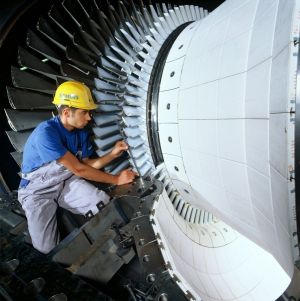The Helmholtz Association will fund new a Helmholtz Research School on “Integrated Materials Development for Novel High-temperature Alloys” at KIT. These materials are characterized by a high melting point and low weight. They may be used for the construction of turbines of enhanced efficiency to be applied in gas power stations or airplanes, for instance. By enhancing energy efficiency, the new alloys contribute to the transformation of the energy system.
Due to the increasing energy consumption and greenhouse gas emissions worldwide, new materials are required for energy conversion, also for conventional technologies. Development of these materials requires scientists thinking and working in an interdisciplinary manner. These demands are met by the Helmholtz Research School “Integrated Materials Development for Novel High-temperature Alloys” at KIT. It will be funded by the Helmholtz Association for the next six years. The Research School will train doctoral students in the development, characterization, and modeling of materials.
Activities will focus on a group of novel materials having a high potential for use in energy technology: Directionally solidified eutectic alloys. Eutectic alloys have a clearly determinable melting point. As all constituents solidify at the same time, a fine, homogeneous structure develops. Examples of such materials are in-situ chromium fiber-reinforced nickel aluminides. “Contrary to ceramic fiber-reinforced composites, these materials can be produced in a single step,” says Professor Martin Heilmaier from the Institute for Applied Materials (IAM) of KIT. “Consequently, energy is saved when producing these alloys already.” Together with Professor Oliver Kraft who heads the IAM, Heilmaier is the spokesperson of the new Helmholtz Research School.
High-temperature alloys can be used for the construction of turbines for stationary operation in gas power plants or mobile use in airplanes. They are characterized by a high oxidation stability. As they have a relatively high melting point, they can be used at higher temperatures than conventional materials. Hence, it is possible to construct turbines of increased efficiency. Moreover, these novel alloys are lighter, as a result of which the weight of airplane turbines can be reduced. Both factors increase the efficiency of energy conversion. Not only conventional plants will benefit from the development of high-temperature alloys. In the long term, these materials might give rise to entirely new technologies.
Through Helmholtz graduate schools and Helmholtz research schools, the Helmholtz Association supports the extension of structured doctoral programs. After this year’s call, 19 proposals were submitted. An expert commission selected two graduate schools and five research schools. They will be funded under the Initiative and Networking Fund of the Helmholtz Association for the next six years. Helmholtz Research Schools focus on specific research topics. Each Research School brings together up to 25 outstanding young doctoral students from Germany or abroad.
Karlsruhe Institute of Technology (KIT) is one of Europe’s leading energy research establishments. The KIT Energy Center pools fundamental research with applied research into all relevant energy sources for industry, households, services, and mobility. Holistic assessment of the energy cycle also covers conversion processes and energy efficiency. The KIT Energy Center links excellent competences in engineering and science with know-how in economics, the humanities, and social science as well as law. The activities of the KIT Energy Center are organized in seven topics: Energy conversion, renewable energies, energy storage and distribution, efficient energy use, fusion technology, nuclear power and safety, and energy systems analysis.
Research, education, and innovation at KIT foster the energy turnaround and reorganization of the energy system in Germany. Clear priorities lie in the areas of energy efficiency and renewable energies, energy storage technologies and grids, electromobility, and enhanced international cooperation in research.
In close partnership with society, KIT develops solutions for urgent challenges – from climate change, energy transition and sustainable use of natural resources to artificial intelligence, sovereignty and an aging population. As The University in the Helmholtz Association, KIT unites scientific excellence from insight to application-driven research under one roof – and is thus in a unique position to drive this transformation. As a University of Excellence, KIT offers its more than 10,000 employees and 22,800 students outstanding opportunities to shape a sustainable and resilient future. KIT – Science for Impact.

